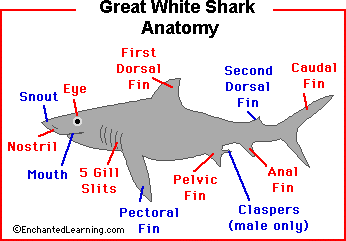Fast facts.
Range of sensory organs:
Sound--distances of a couple of miles
Smell--distances of several football fields
Lateral line--distances of several football fields
Vision--distances of dozens of feet
Amp. of Lorenzini--distances of several feet
Touch & taste--contact
It is thought that the shark uses the strongest sensory stimulus first and then shifts to whichever sense is stimulated most as it meets its prey.
Physiology:
. 2 dorsal fins
· 1 pair pectoral, 1 pair pelvic fins
· Protruding snout with nostrils
· Crescent-shaped mouth
· Spiracle opening in posterior to eyes (evolutionary remnant of bony fish gill slit, not present in some species) - Dermal denticles in place of scales like bony fish. - Multiple rows of teeth, up to eight functional rows. The structure/shape of teeth varies with species and their diets. Replacement teeth are larger that tooth being replaced. The rate of tooth replacement varies with species, may be from eight days to a full year, with the teeth replaced singly or complete row at once.
· Sharks lack the air bladder of bony fish to maintain buoyancy. Some sharks such as the sand tiger are gulpers and surface periodically to swallow air to assist in buoyancy.
· Large liver, can occupy as much as 90% of the body cavity or be 25% of the body weight in some species. Adds buoyancy because oils of liver have lower specific gravity than surrounding water. In fact, production of liver oils is controlled by the shark to help compensate for buoyancy changes. Still, sharks are slightly negative and will sink if they stop swimming.

|
Evolution of sharks
Sharks make up the Chondrichthyes or "cartilaginous fish." First appearing on Earth almost 450 million years ago, cartilaginous fish include both predators like the sand tiger and harmless mollusc-eaters like the Atlantic stingray. Members of Chondrichthyes are boneless and have a skeleton composed of cartilage (a flexible structure like the ones in your nose and ears). their teeth are calcified. Cartilage has a different structure from that of true bone. Most sharks eat fish, squid, marine mammals, and scavenge any other available food source.
The shark has developed over millions of years into one of the worlds most perfect predators. It is a highly developed eating machine.
Sight:
Sharks are slightly farsighted and see in color. Their eyes can function in light ten times dimmer than that of the human eye because of a shiny reflective pigment called tapetum lucidum that is also found in cats’ eyes. Some sharks posses a nictitating membrane which closes to protect the eye as the shark attacks prey. In sharks such as the great white the eye rolls upward for protection just before the shark bites.
Hearing:
Sharks are attracted to low frequency, pulsing sounds such as the sounds made by injured or dying fish.
Lateral Lines:
Series of fluid-filled canals containing hair-like receptors (similar to the cochlea of the human ear) which extend along the sides of the head and body. These sense vibration, change in pressure, movement and sound.
Olfaction:
The sharks’ nostril can sense blood in the water as little as one part per million from a mile away. Lemon sharks can sense fish oil in water one part per 25 million or the equivalent of just ten drops in an average home swimming pool, Caribbean reef sharks can sense grouper flesh concentrations as low as one part per 10 billion or the equivalent of one drop in a quarter acre pond.
Ampullae of Lorenzini:
Receptor cells located at base of canals on sharks’ snout, lower jaw and around the eyes. The Ampullae of Lorenzini detect electrical fields, their direction, and strength. Every living creature gives off an electrical field which provides a stimulus or homing device for the shark. Some sharks can detect a change in direction of electrical intensity five-billionths of a volt per centimeter in a range of 0-8 Hertz. This sense can also be used to detect changes in the sharks’ own bioelectrical field. It is believed that sharks use this sense to detect changes in the earths’ magnetic field and for navigation.
|

